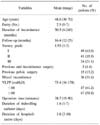Abstract
Purpose
The aim of this study was to evaluate the results of performing the suprapubic arc (SPARC) procedure during 14 months at our hospital for treating female stress urinary incontinence.
Materials and Methods
Between October 2002 and December 2003, 114 consecutive women who suffered with stress urinary incontinence underwent the SPARC procedure. All the patients were followed up for at least 1 year. The patients were preoperatively evaluated via taking their medical history, physical examinations, and conducting urinalysis and voiding cystourethrography and urodynamic studies, including determining the Valsalva leak point pressure (VLPP). Evaluations were conducted by questionnaires and interviews for determining the surgical outcome and the patients' satisfaction.
Results
The mean age was 48.6 years (30-70), the mean follow-up period was 16.4 months (12-25), the mean hospital stay was 3.8 days (2-10) and the mean operation time was 38.7 minutes. For 114 patients, 92 (80.7%) were cured and 17 (14.9%) were significantly improved. 99 patients (86.8%) were satisfied with the SPARC procedure, and 95 patients (83.3%) would like to recommend the SPARC procedure to others. Intraoperative complications included 9 (7.9%) bladder perforations and 1 (0.9%) urethral injury. Postoperative complications showed 14 cases (12.3%) of urinary retention, 2 cases (1.8%) of vaginal wound infections and 1 case (0.9%) of vaginal erosion due to tape. De novo urge incontinence was noted in 3 patients (2.6%).
Figures and Tables
References
1. Iosif CS, Belkassy Z, Rydhstrom H. Prevalence of urinary incontinence in middle-age women. Int J Gynaecol Obstet. 1988. 26:255–259.
2. Ulmsten U, Henriksson L, Johnson P, Varhos G. An ambulatory surgical procedure under local anesthesia for treatment of female urinary incontinence. Int Urogynecol J Pelvic Floor Dysfunct. 1996. 7:81–86.
3. Deval B, Levardon M, Samain E, Rafii A, Cortesse A, Amarenco G, et al. A French multicenter clinical trial of SPARC for stress urinary incontinence. Eur Urol. 2003. 44:254–259.
4. Kassardjian ZG. Sling procedures for urinary incontinence in women. BJU Int. 2004. 93:665–670.
5. Kobashi KC, Govier FE. Perioperative complications: the first 140 polyprolene pubovaginal slings. J Urol. 2003. 170:1918–1921.
6. Ulmsten U, Johnson P, Rezapour M. A three-year follow up of tension free vaginal tape for surgical treatment of female stress urinary incontinence. Br J Obstet Gynaecol. 1999. 106:345–350.
7. Nilsson CG, Kuuva N, Falconer C, Rezapour M, Ulmsten U. Long-term results of the tension-free vaginal tape (TVT) procedure for surgical treatment of female stress urinary incontinence. Int Urogynecol J Pelvic Floor Dysfunct. 2001. 12:Suppl 2. S5–S8.
8. Siddiqui K, Grainger R. Preliminary experience with SPARC pubovaginal sling in treatment of female stress urinary incontinence. BJU Int. 2004. 94:Suppl 2. 252–253. abstract 3.
9. Primus G. SPARC-sling system for the treatment of female urodynamic stress urinary incontinence an unicenter prospective study with 2 years follow-up. BJU Int. 2004. 94:Suppl 2. 250. abstract 13.
10. Tseng LH, Wang AC, Lin YH, Li SJ, Ko YJ. Randomized comparison of the suprapubic arc sling procedure vs tension-free vaginal taping for stress incontinent women. Int Urogyncol J Pelvic Floor Dysfunct. 2005. 16:230–235.
11. Bump RC, Mattiasson A, Bo K, Brubaker LP, DeLancey JO, Klarskov P, et al. The standardization of terminology of female pelvic organ prolapse and pelvic floor dysfunction. Am J Obstet Gynecol. 1996. 175:10–17.
12. Romanzi LJ, Chaikin DC, Blaivas JG. The effect of genital prolapse on voiding. J Urol. 1999. 161:581–586.
13. Olsen AL, Smith VJ, Bergstrom JO, Colling JC, Clark AL. Epidemiology of surgically managed pelvic organ prolapse and urinary incontinence. Obstet Gynecol. 1997. 89:501–506.
14. Cross CA, Cespedes RD, McGuire EJ. Our experience with pubovaginal slings in patients with stress urinary incontinence. J Urol. 1998. 159:1195–1198.
15. Ng CS, Rackley RR, Appell RA. Incidence of concomitant procedure for pelvic organ prolapse and reconstruction in women who undergo surgery for stress urinary incontinence. Urology. 2001. 57:911–913.
16. Dupont MC. Comparison of SPARC™ with tension-free vaginal tape in treating stress urinary incontinence. BJU Int. 2003. 91:Suppl 2. 91. abstract 124.
17. Ward KL, Hilton P. A prospective multicenter randomized trial of tension-free vaginal tape and colposuspension for primary urodynamic stress incontinence: two-year follow-up. Am J Obstet Gynecol. 2004. 190:324–331.
18. Tsivian A, Kessler O, Mogutin B, Rosenthal J, Korczak D, Levin S, et al. Tape related complications of the tension-free vaginal tape procedure. J Urol. 2004. 171:762–764.
19. DeTayrac R, Deffieux X, Droupy S, Chauveaud-Lambling A, Calvanese-Benamour L, Fernadez H. A prospective randomized trial comparing tension-free vaginal tape and transobturator suburethral tape for surgical treatment of stress urinary incontinence. Am J Obstet Gynecol. 2004. 190:602–608.
20. Park SC, Hong BS, Choo MS. Risk factors related to immediate urinary retention after tension-free vaginal tape procedure. Korean J Urol. 2003. 44:503–508.
21. Segal JL, Vassallo B, Kleeman S, Silva WA, Karram MM. Prevalence of persistent and de novo overactive bladder symptoms after the tension-free vaginal tape. Obstet Gynecol. 2004. 104:1263–1269.
22. Rezapour M, Ulmsten U. Tension-free vaginal tape (TVT) in women with mixed urinary incontinence: a long term follow-up. Int Urogynecol J Pelvic Floor Dysfunct. 2001. 12:Suppl 2. S15–S18.
23. Meschia M, Pifarotti P, Bernasconi F, Guercio E, Maffiolini M, Magatti F, et al. Tension-free vaginal tape: analysis of outcomes and complications in 404 stress incontinent women. Int Urogynecol J Pelvic Floor Dysfunct. 2001. 12:Suppl 2. S24–S27.
24. Kobashi KC, Govier FE. Perioperative complications: the first 140 polypropylene pubovaginal slings. J Urol. 2003. 170:1918–1921.
25. Stanford E, Dell J. Physician satisfaction with the SPARC™ suprapubic sling system: an opinion-based survey. J Pelv Med Surg. 2005. 11:Suppl. 77–78. abstract 23.




 PDF
PDF ePub
ePub Citation
Citation Print
Print








 XML Download
XML Download